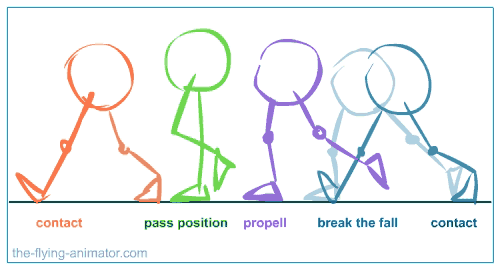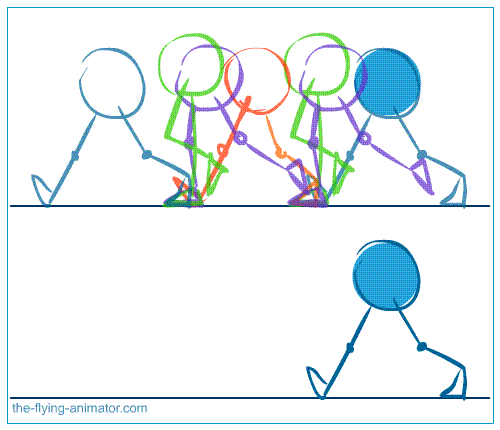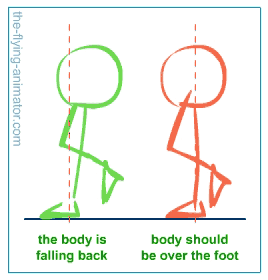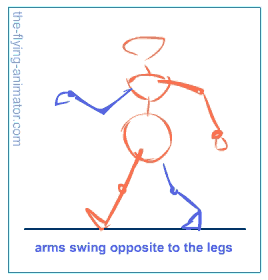How to Animate a Walk Cycle
The key to animating a walk cycle is to understand how the legs PUSH THE MASS of the body forward, and how the feet connect with the ground.
When we walk we move our MASS in four stages:
- The front foot makes contact with the ground,
- The mass of the body falls on that foot and the leg bends, cushioning the fall,
- We then use the momentum to propel our mass forward again,
- One leg supports the body weight while the other passes forward for the next step.
This illustration shows one step - remember to animate the second leg!
 Key frames for a walk cycle
Key frames for a walk cycleThe Key Frames
To animate a walking cycle, you need three key frames (1, 2 and 3 in the list above), and one breakdown position ( 4 ) the passing position.
Most walking cycles work best at 9 frames per step = 18 frame cycle for both feet.
The animation presented here below is slower - this is a 24 frames walkcycle (for both legs) at 24 fps:

Faster than 18 frames is starting to be a run.
See some tips for animating a Run Cycle.
You might also want to animate a Walk from the front- Click here to see the keys.
Important tips for creating walk cycle animation
The most important question of all is:
1. Where is the MASS?

The mass needs to be above the feet and slightly forward.
The more forward it leans, the faster your character should walk.
Look out for a common mistake - check each frame and make sure the body didn't get left behind... (maybe it doesn't want to go? :-)
The best way to animate is to move the big mass first, and then the rest of the body.
Whenever you get confused, ask yourself this:
Which leg supports the weight in the frame I'm animating now?
The answer will solve 90% of all your problems.
This leads us to the second most important thing:
2. Keep your feet on the ground!
Make sure the feet keep good contact with the ground - don't let them slip.
Here is the logic of it:
If a foot now supports the body weight, then IT CANNOT MOVE!
Cool hah?
SO when you animate - determine which foot supports the weight, and FREEZE it.
Disable the tweens.
Delete foot keyframes until you reach a frame when this foot must move again - and the other foot takes on the weight.
3. The body mass goes up and down
As we walk, our legs push our bodies upward as well as forward, and we rise and fall with each step.
The lowest part is the bounce, key frame #2, when the front leg receives the weight and bends under it.
The highest part is the passing position, where we stand on one straight leg. (Green Passing Position break-down frame)
Different Walks
The above formula is just that:
A formula.
You need to modify it for your characters. Here are some things to consider:
- For a Massive man - make slower steps and a deeper bounce (go lower on key #2).
- Woman on high heels - small steps, almost no bounce, mass barely moves up and down.
- Bugs Bunny style "double bounce" - add another dip in the passing stage. (Another #2, so to speak).
Play with the break down - especially the passing position - to give your
An "Advancing Walk Cycle" vs. a "Moon-walk" cycle
If you're creating a walk cycle animation for a game, you might want it to happen "on the spot".
In my experience it's best to animate a normal advancing double step first, and only when you're happy with it, "squeeze" the key frames in.
Mark the center of gravity with a guide line and cut and paste the character in each frame to this center.
Swinging the Arms

The arms swing back and forth opposite to the legs.
When the right foot is forward - the right arm goes backwards.
Passing position for the arms happens together with the legs passing position.
That's it!
Now all you have to do is walk the walk :-)
Walking forward: Click here to see how to animate a walk from the front
Run-don't-Walk: Running Cycle Tutorial
Home > Animation Tutorials > Walk Cycle
In this Section
walk cycle
walk cycle front
run cycle
You might also like
Recording soundtrack - Master Class
